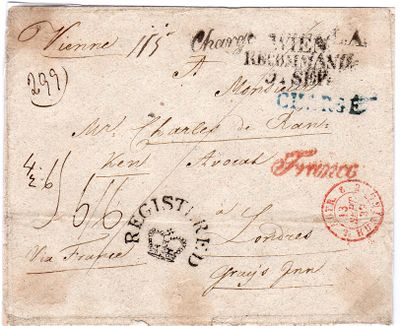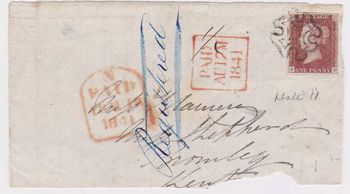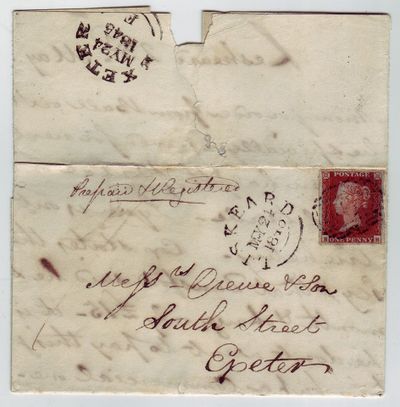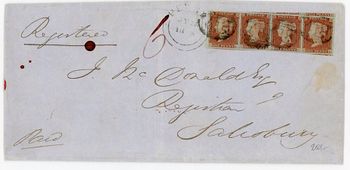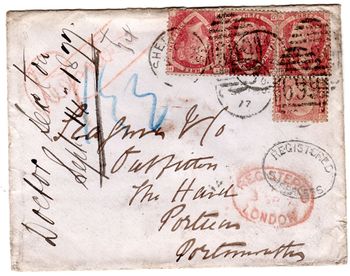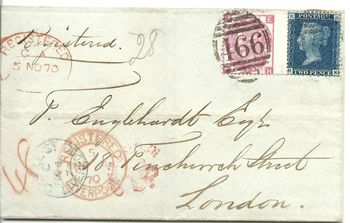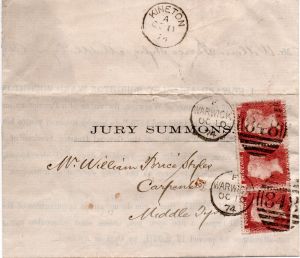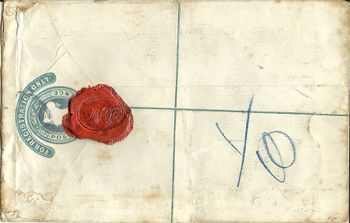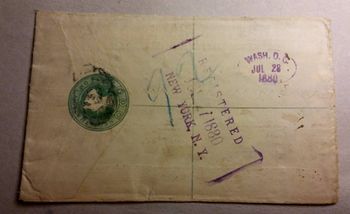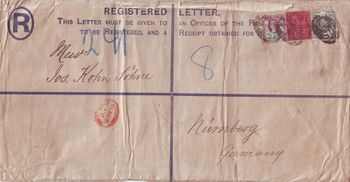GB Registration during the reign of Queen Victoria
Just prior to Queen Victoria's reign and the introduction of the postage stamp, the postal system of the Genertal Post Office (G.P.O.) was being established from what had been the King's mail system and being extended to a public system.
This page attempts to deal with the development of the Registration period up to 1901
N.B. This page has been added as part of the postmarks set up as the development of the system relied on postal markings to signify the type of letters.
See Also: Registered Postmarks
Contents
- 1 1792 Money Letter system introduced
- 2 1824 Bankers Parcel system
- 3 1823-1831 Irish System of Free Registration
- 4 before 1840 Foreign Mail Registration
- 5 1840 End of Money Letter System
- 6 1841 Modern Registered Postal system introduced
- 6.1 1841 Introduction of 1s Rate of Registration
- 6.2 1848 6d Rate introduced
- 6.3 1862 4d Rate introduced
- 6.4 1878 Introduction of the 2d Rate for Registration
- 6.5 1886 Increased compensation 2d Rate
- 6.6 1887 Increased compensation 2d Rate up to £10 max compensation scheme
- 6.7 1891 Introduction of 'Parcel Registration - 6d Maximum Registration Fee up to £25 compensation scheme
- 6.8 1892 Increased level of Compensation for Registered Post - 11d Maximum Registration Fee up to £50 compensation scheme
- 6.9 1898 to 1901 Increased level of Compensation for Registered Post - 1s 2d Maximum Registration Fee up to £120 compensation scheme
Pre-Queen Victoria until 1837
========================================================================================
1792 Money Letter system introduced
The introduction of the Money Letter system in GB in 1792 gave assurance to the passage of letters containing cash (in gold or silver) or jewellery. Letters containing "valuable Paper" only were not covered. However there was no compensation for anything that was lost, just an added assurance of carriage, as the letter was noted on letter-bills in transit and a receipt taken on delivery. Such letters were designated on the cover as a Money Letter or Cash Letter. There was no specific rate for such carriage, but as a Money Letter by definition contained at least one enclosure it was subject to at least a double charge.
This system ended on the 1st of January 1840, shortly before the introduction of the uniform 1d rate of postage for letters anywhere in the country on 10th January (it was feared that the number of such letters would be too many to handle given the expected increase in letters sent).
1824 Bankers Parcel system
In 1824 the post office introduced a special rate for parcels of banknotes being returned from London to the provincial banks that issued them. Such parcels had to weigh at least 6 ounces and contain only banknotes, and were charged one quarter of the standard postage rate. A special office was set up in London to handle them and a distinct dated Crown Postmark was used.
1823-1831 Irish System of Free Registration
A system of free registration was used by the Irish Post Office in 1823 for all double or larger paid letters (unpaid added from 1827). This remained the case until the British system was adopted when the Irish PO came under direct London control again in 1831. The Money Letter system appears to have run in parallel. Some letters bear a dated registration handstamp.
before 1840 Foreign Mail Registration
Mail going abroad could be registered for £1.1.0. Incoming mail was charged 5s. From 20th July 1836 the rates became 2s 6d in either direction (then from 1837 double postage to a maximum of 2s 6d).
Queen Victoria comes to the throne in 1837
========================================================================================
1840 End of Money Letter System
1841 Modern Registered Postal system introduced
1841 Introduction of 1s Rate of Registration
This fee of 1/- had to be paid in cash however the postage could be paid either in cash or stamps.
1848 6d Rate introduced
Following in the decrease of the rate from 1/- to 6d in 1848 the fee had to be paid in cash but all postage now had to be paid in stamps.
In 1850 Postmasters were then sent a circular notice instructing them to affix stamps to letter to denote fee had been paid from 1st June 1850
All letters had to be endorsed "REGISTERED" and given a accounting number recorded in the sending offices books.
1862 4d Rate introduced
Introduction of Compulsory registration for letters containing coins was introduced. The general rate was reduced at the same time.
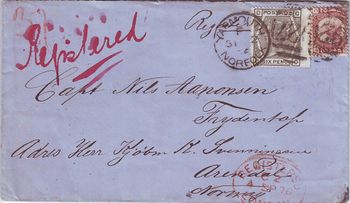 4d registration period 1876 Postage of 2½d Yarmouth to Norway, with blood red handwritten "Registered". Red London Registered oval at bottom right. |
 1864 Brighton to Norway. 1/- postage and 4d registration on pre UPU period registered cover. Crown registered postal marking and London Registered marks. Red PD (Paid to destination) oval |
Exception Jury Service Notification
Clause 11 of the Juries Act 1862 allowed for jurors in England and Wales to be summoned by post. The words "Jury Summons" were to be written or printed on the address side of the summons, which was to be brought to any Money Order post office in duplicate, one copy to be sent registered to the juror, the other to be datestamped and returned to the relevant legal office as proof of posting. The Act specified that the Notices were to be registered, at a concessionary registration fee of not more than 2d (plus postage).
The same rule for service by registered letter at a reduced fee was introduced in 1873 under Acts of 1871 and 1872 for the County of Dublin, extended to the whole of Ireland at the discretion of the judge of assize in 1876 (GBPS)
1878 Introduction of the 2d Rate for Registration
In 1878 the fee dropped to just 2d and compensation for loss was offered for the first time (up to £2).
- 2d registration - compensation up to £2
At the same time postal stationery registration envelopes were introduced with a 2d embossed stamp which covered the basic registration fee. Stamps were added to cover the 'Postage of the letter to its destination.
1886 Increased compensation 2d Rate
In 1886 the rate remained at 2d for registration however there was an increase in the amount of compensation payable the basic 2d fee still covered to £2. However now further compensation rates could be achieved by the payment of an additional fee.
- 2d basic compensation up to £2
- 2d basic + additional 1d offered compensation up to £5
- 2d basic + additional 2d offered compensation up to £10
These additional payments had to be made at a counter and recorded on a special certificate of posting with stamps affixed to cover the addition. Therefore these additional stamps will not be seen on the covers.
1887 Increased compensation 2d Rate up to £10 max compensation scheme
Due to an increase in the use of the registration scheme it was decided to abolish the additional 1d that covered up to £5 and instead the GPO raised the basic level(2d rate) to cover the compensation up to £5. However an additional payment was still required for the full £10 cover.
- 2d basic compensation up to £5
- 2d basic + additional 2d offered compensation up to £10
1891 Introduction of 'Parcel Registration - 6d Maximum Registration Fee up to £25 compensation scheme
The Parcel post scheme that was introduced in 1883 covered the postage of parcels to their destinations, however there was no compensation for loss. Parcels tended to have high value to the senders and the PO was at first unwilling to cover as such.
However due to increased regulation and success of registration items and a reduction in claims, it was decided that parcels could come under the registration system. In 1891 this came into effect when there was also a further change in the scale of compensation introduced which also covered the compensation available to parcels and letters alike. In effect the Insurance became a Registration fee payable in stamps, which had to be affixed to the item being sent. Additionally the scheme made it necessary to also mark the items with the amount of 'Registration Fee' paid.
- 2d Registration paid cover up to £5 in compensation payable
- 3d Registration paid cover up to £10 in compensation payable
- 4d Registration paid cover up to £15 in compensation payable
- 5d Registration paid cover up to £20 in compensation payable
- 6d Registration paid cover up to £25 in compensation payable
1892 Increased level of Compensation for Registered Post - 11d Maximum Registration Fee up to £50 compensation scheme
After a further year the Post Office were happy to increase the fee/compensation scheme to cover larger losses.
- 2d Registration paid cover up to £5 in compensation payable
- 3d Registration paid cover up to £10 in compensation payable
- 4d Registration paid cover up to £15 in compensation payable
- 5d Registration paid cover up to £20 in compensation payable
- 6d Registration paid cover up to £25 in compensation payable
- 7d Registration paid cover up to £30 in compensation payable
- 8d Registration paid cover up to £35 in compensation payable
- 9d Registration paid cover up to £40 in compensation payable
- 10d Registration paid cover up to £45 in compensation payable
- 11d Registration paid cover up to £50 in compensation payable
1898 to 1901 Increased level of Compensation for Registered Post - 1s 2d Maximum Registration Fee up to £120 compensation scheme
The final increase in registration and composition of the QV reign was to raise the maxim fee to 1 shilling 2d and to finally raise compensation to £120 maximum based on fee paid. This increase would eventually follow through into the reign of Edward VII. From the first printings of the embossed stationery of Ed VII in 1902 the registration & Postage would be included in the same fee.
- 2d Registration paid cover up to £5 in compensation payable
- 3d Registration paid cover up to £10 in compensation payable
- 4d Registration paid cover up to £20 in compensation payable
- 5d Registration paid cover up to £30 in compensation payable
- 6d Registration paid cover up to £40 in compensation payable
- 7d Registration paid cover up to £50 in compensation payable
- 8d Registration paid cover up to £60 in compensation payable
- 9d Registration paid cover up to £70 in compensation payable
- 10d Registration paid cover up to £80 in compensation payable
- 11d Registration paid cover up to £90 in compensation payable
- 1s Registration paid cover up to £100 in compensation payable
- 1s 1d Registration paid cover up to £110 in compensation payable
- 1s 2d Registration paid cover up to £120 in compensation payable
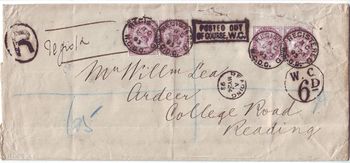 POSTED OUT OF COURSE POOC - If marked registered mail was posted in an ordinary post box, then they were treated as Registered mail but charged the registered fee regardless of the stamps affixed. Some period fees were just for the registration deficiency amount, but later this was doubled. This letter had been posted with 4d in stamps (1d postage and 3d Registered) as registered in a post box, but has been charged 6d (double rate) for doing so. |
|
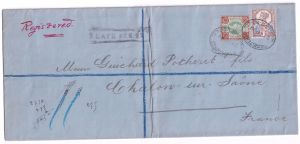 Mark Lane London E.C. office cover to sent at the 1oz 5d Rate plus 2d Registration and 2d Late Fee to Chalon-sur-Saone, France |
N.B. From the first printings of the embossed stationery of Ed VII in 1902 the registration & Postage would be included in the same fee.
